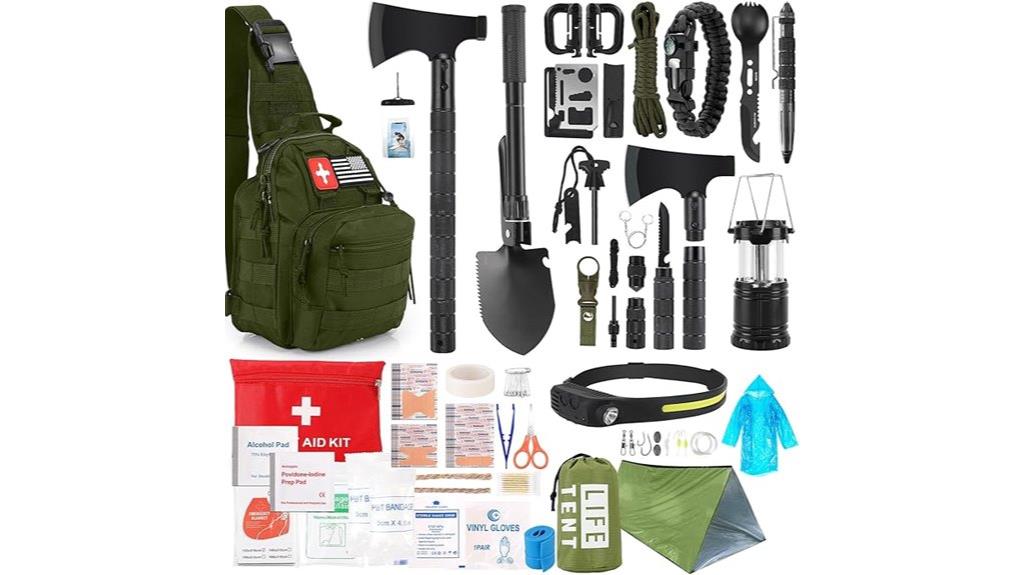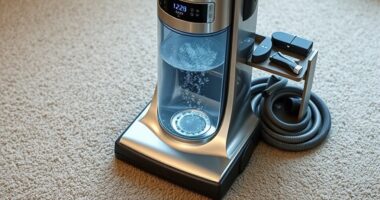I’ve found two top emergency power supplies that are reliable for medical equipment. They offer solid power capacity, portability, and compatibility to meet critical needs. Both units also feature long-lasting batteries and essential safety certifications, ensuring reliable operation during outages. Proper safety features like overload protection and alarms add extra security. If you want to make the best choice for your situation, keep exploring—the right system could make all the difference when it matters most.
Key Takeaways
- Choose units with sufficient power capacity and runtime to support critical medical devices during outages.
- Prioritize portable, easy-to-transport power supplies with compatibility for various medical equipment standards.
- Ensure systems include essential safety features like overload protection, surge suppression, and automatic shutoff.
- Verify certifications such as UL, CSA, or ISO to confirm safety, reliability, and compliance with medical standards.
- Regularly test and maintain power supplies to guarantee performance and readiness in emergency situations.
Survival Kit with Emergency Gear and Supplies

If you’re looking for a reliable survival kit that can keep your family safe during emergencies, this all-encompassing set is the perfect choice. It includes 251 carefully selected survival tools and medical supplies, designed to support you through the first 72 hours of any crisis. Whether facing earthquakes, wildfires, or power outages, this kit has you covered. It’s versatile enough for outdoor adventures like hiking and camping too. With its durable tactical backpack, organized compartments, and life-saving medical pouch, you’ll be prepared for almost anything. It makes a thoughtful gift for safety-conscious loved ones or anyone wanting to be ready for unexpected events.
Best For: individuals, families, preppers, and outdoor enthusiasts seeking comprehensive emergency preparedness and survival gear.
Pros:
- Contains 251 survival tools and medical supplies curated with experts for reliable emergency response
- Designed to sustain individuals and families through the critical first 72 hours of crises
- Features durable, organized tactical backpack for easy access and portability
Cons:
- The large number of items may be overwhelming for beginners to organize and utilize effectively
- The kit’s weight and size could be cumbersome to carry during extended outdoor activities
- Some users might find the price point high compared to basic survival kits with fewer items
Survival Kit with 268 Pcs Emergency Gear and Supplies

Are you prepared to handle unexpected emergencies with confidence? I’ve found that a well-stocked survival kit with 268 pcs of emergency gear and supplies is essential. It includes first aid essentials, survival tools, fire-making items, shelter gear, and emergency lighting—perfect for outdoor adventures, home safety, or travel mishaps. Weather-tested and reliable in harsh conditions, it helps manage floods, storms, and power outages. Its organized compartments and durable design make quick access easy, whether in your car, backpack, or RV. This versatile kit offers peace of mind, ensuring you’re ready for any situation, big or small.
Best For: outdoor enthusiasts, travelers, and homeowners seeking comprehensive emergency preparedness and reliable survival gear.
Pros:
- All-in-one kit with 268 essential emergency items for versatile use
- Weather-tested and durable design suitable for harsh environments
- Portable and organized with multi-compartment layout for quick access
Cons:
- May be bulky for minimalist travelers or small backpacks
- Some items could be redundant for experienced survivalists
- The initial cost might be higher compared to purchasing individual components
Factors to Consider When Choosing Emergency Power Supply for Medical Equipment

When selecting an emergency power supply for medical equipment, I focus on several key factors. I consider the power capacity needed, how portable and compact it is, and how long the battery can last during outages. Ensuring compatibility and reliability in emergencies is vital to keep everything running smoothly.
Power Capacity Needs
Selecting the right emergency power supply for medical equipment requires accurately determining the total wattage and amperage needed. I start by evaluating each device’s power requirements, including their peak startup loads, which often demand higher initial power. It’s vital to appraise how long each device must run during outages to guarantee continuous operation. I also consider potential future expansions or additional equipment that might increase power demands over time. To ensure reliability, I choose a power supply with a safety margin above the calculated needs, accommodating voltage fluctuations and unexpected surges. This approach helps prevent overloads and guarantees that all critical devices remain operational during emergencies. Properly assessing power capacity is critical for maintaining patient safety and equipment functionality when it’s needed most.
Portability and Size
How do you choose an emergency power supply that’s both portable and effective for medical equipment? First, consider its weight and size—lightweight and compact units are easier to carry during emergencies or outdoor use. The size also influences battery capacity; smaller units may be more portable but might not provide enough runtime for critical devices. If you need mobility, look for a balance: a unit that’s small enough to transport easily but still offers sufficient power. Larger portable units can deliver longer backup times and extra features but tend to be bulkier, making them harder to move quickly. Always evaluate your physical capabilities and how you’ll store or carry the unit to ascertain it’s practical for your specific needs.
Battery Life Duration
Long-lasting battery life is essential because it directly impacts how long medical equipment can keep running during power outages, guaranteeing continuous patient care. A longer battery life is especially critical for essential devices like ventilators or infusion pumps that need uninterrupted power. When choosing an emergency power supply, I consider the estimated runtime based on the device’s power consumption and the battery’s capacity, measured in milliamp-hours or watt-hours. Some units offer multiple batteries or swappable modules, allowing me to extend operational time during prolonged outages. Regular testing and maintenance are also indispensable to ensure the battery performs reliably when I need it most. By prioritizing battery life duration, I can better guarantee that my medical equipment remains functional during emergencies.
Compatibility With Devices
Ensuring compatibility between the emergency power supply and your medical devices is crucial to prevent damage and guarantee reliable operation. First, check that the power supply provides the correct voltage and amperage specified for your equipment, preventing potential malfunctions. Confirm that the plug types and connector standards match your devices to avoid connection issues. Consult the manufacturer’s manual for recommended power input and compatibility requirements. Additionally, verify that the power supply can support your device’s startup surge current, especially for equipment with motors or amplifiers. Safety features like surge protection and overload shutdown should align with your device’s operational needs to ensure safe and consistent performance during power outages. Proper compatibility minimizes risks and ensures your medical equipment functions seamlessly when you need it most.
Reliability in Emergencies
Choosing an emergency power supply for medical equipment requires careful consideration of its proven performance during outages and disasters. I look for systems with a solid track record of reliability, ensuring they perform consistently when needed most. Certifications like UL, CSA, or ISO give me confidence that the device meets safety and performance standards. I also prioritize backup systems—such as UPS or generators—that automatically activate, preventing any delay in power. Regular maintenance and testing are essential to confirm the system works flawlessly during an emergency. Additionally, the power supply must have enough capacity and runtime to support critical devices throughout the entire event. Reliability isn’t just about design but also ongoing checks, ensuring these systems will deliver when every second counts.
Safety and Certifications
Have you ever considered how crucial safety certifications are when selecting an emergency power supply for medical equipment? These certifications, like UL, CE, or ISO, confirm that the device meets essential safety standards, ensuring reliable operation during emergencies. It’s essential to verify that the power supply includes overload protection, short circuit prevention, and surge suppression to shield sensitive equipment from damage. Automatic shutoff features or alarms are also important; they alert you to potential malfunctions or hazards instantly. Additionally, confirming compliance with medical device regulations guarantees safe, dependable performance. Look for units with clear labeling of safety features and certifications—this makes quick assessment easier during critical moments. Prioritizing safety and certification helps ensure that your emergency power supply performs flawlessly when it matters most.
Frequently Asked Questions
What Is the Typical Lifespan of a Backup Power Supply for Medical Devices?
The typical lifespan of a backup power supply for medical devices is usually around 3 to 5 years. I recommend regularly testing and maintaining your system to guarantee it functions when needed. Batteries tend to degrade over time, so replacing them before failure is essential. Proper upkeep and timely replacements help keep your medical equipment running smoothly during power outages, giving you peace of mind.
How Often Should Emergency Power Supplies Be Tested or Maintained?
I recommend testing your emergency power supplies at least once every three to six months. Regular maintenance is vital to guarantee they function properly during an outage. I also suggest performing a full load test annually to verify capacity. Keep detailed records of all checks and maintenance. This proactive approach helps catch issues early, giving you peace of mind knowing your equipment will be reliable when you need it most.
Are There Portable Emergency Power Options Suitable for Home Medical Use?
Absolutely, there are portable emergency power options perfect for home medical use. Think of them as your reliable sidekick during power outages—compact, easy to carry, and designed to keep critical devices running. I recommend looking into portable battery generators or UPS units tailored for medical needs. They’re a lifeline, ensuring you stay connected and safe when the lights go out. Don’t wait—be prepared, and keep your health protected.
What Certifications Should Emergency Power Supplies for Medical Equipment Have?
You should look for emergency power supplies that have certifications like UL (Underwriters Laboratories), UL 1449 for surge protection, and IEC standards for safety and performance. These certifications make certain the device meets strict safety and reliability guidelines. I always recommend checking for FDA approval if it’s medical-grade equipment. When I select a power supply, I prioritize these certifications to guarantee it’s safe and dependable during emergencies.
How Do Temperature Extremes Affect the Reliability of Emergency Power Systems?
Think of emergency power systems as fragile glass, easily shattered by temperature extremes. When it’s too hot, components can overheat, risking failure like a candle melting in the heat. Cold temperatures cause batteries to slow down, like a clock frozen in time. These extremes strain the system, making it less reliable just when you need it most. Proper insulation and temperature regulation are essential to keep this glass intact and dependable.
Conclusion
So, after all this, you’d think choosing an emergency power supply for medical gear would be simple, right? Turns out, it’s almost like picking a trusted friend—reliable, safe, and always ready. Ironically, the most high-tech option still needs to be practical and portable. But hey, if you pick the right one, you’ll be prepared for those “just in case” moments—because who doesn’t love a little peace of mind, especially when lives are on the line?









